NURS3002 PEP Assignment 3: Standards and Domains in Nursing Practice
VerifiedAdded on 2023/06/16
|15
|4468
|281
Report
AI Summary
This report critically analyzes nursing practice, focusing on standards and domains within a professional setting. It uses experiences from a placement at La Mcwin hospital's acute medical ward to demonstrate critical thinking, therapeutic relationships, and patient safety. The report details pain assessment, cultural sensitivity, and communication strategies, emphasizing the importance of establishing trust and maintaining professional boundaries. It also highlights interventions for mobility and circulatory system complications, along with measures to ensure patient safety and quality care through proper documentation and coordination. The analysis is supported by credible literature and standards, aligning with the NURS3002 assignment guidelines.
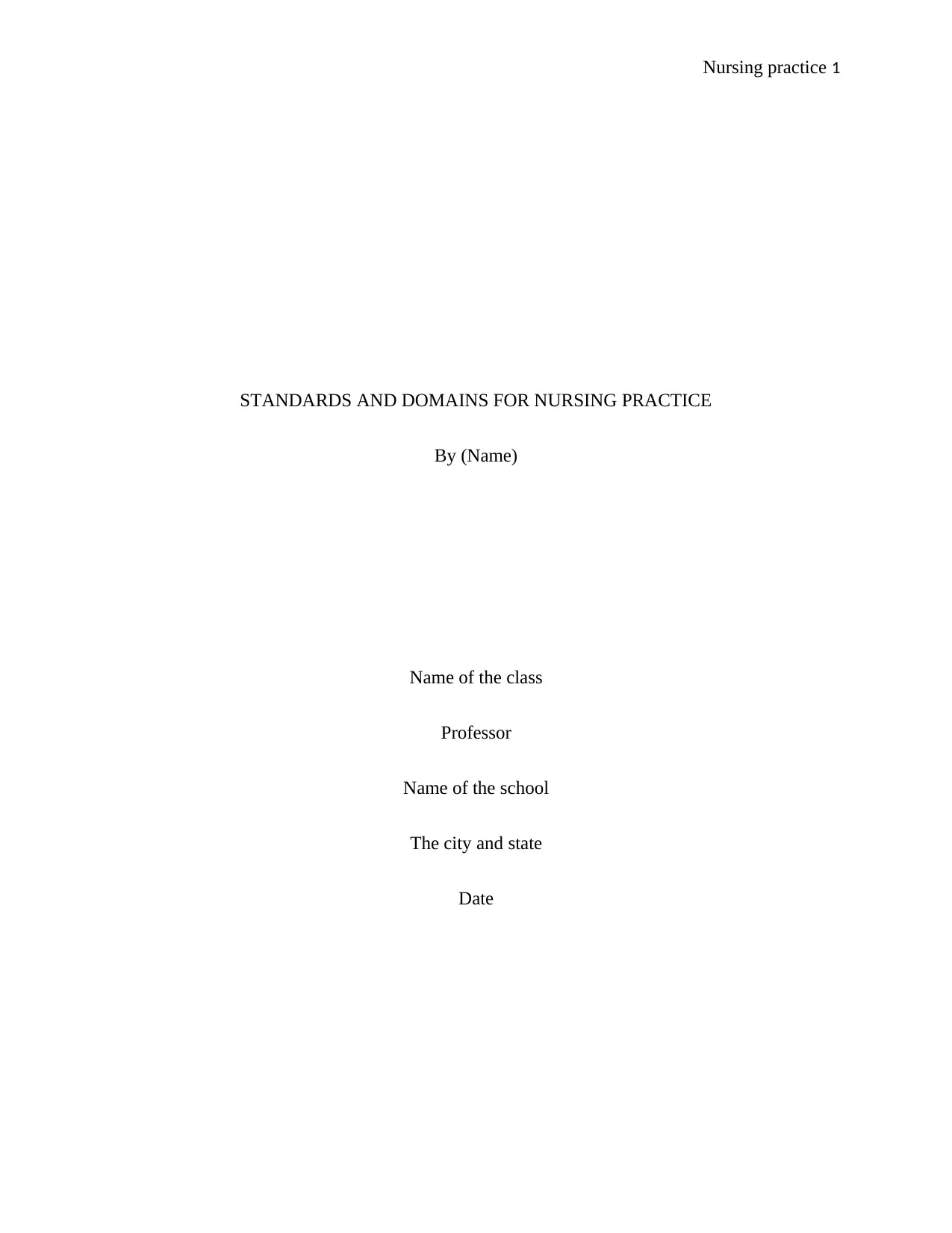
Nursing practice 1
STANDARDS AND DOMAINS FOR NURSING PRACTICE
By (Name)
Name of the class
Professor
Name of the school
The city and state
Date
STANDARDS AND DOMAINS FOR NURSING PRACTICE
By (Name)
Name of the class
Professor
Name of the school
The city and state
Date
Paraphrase This Document
Need a fresh take? Get an instant paraphrase of this document with our AI Paraphraser
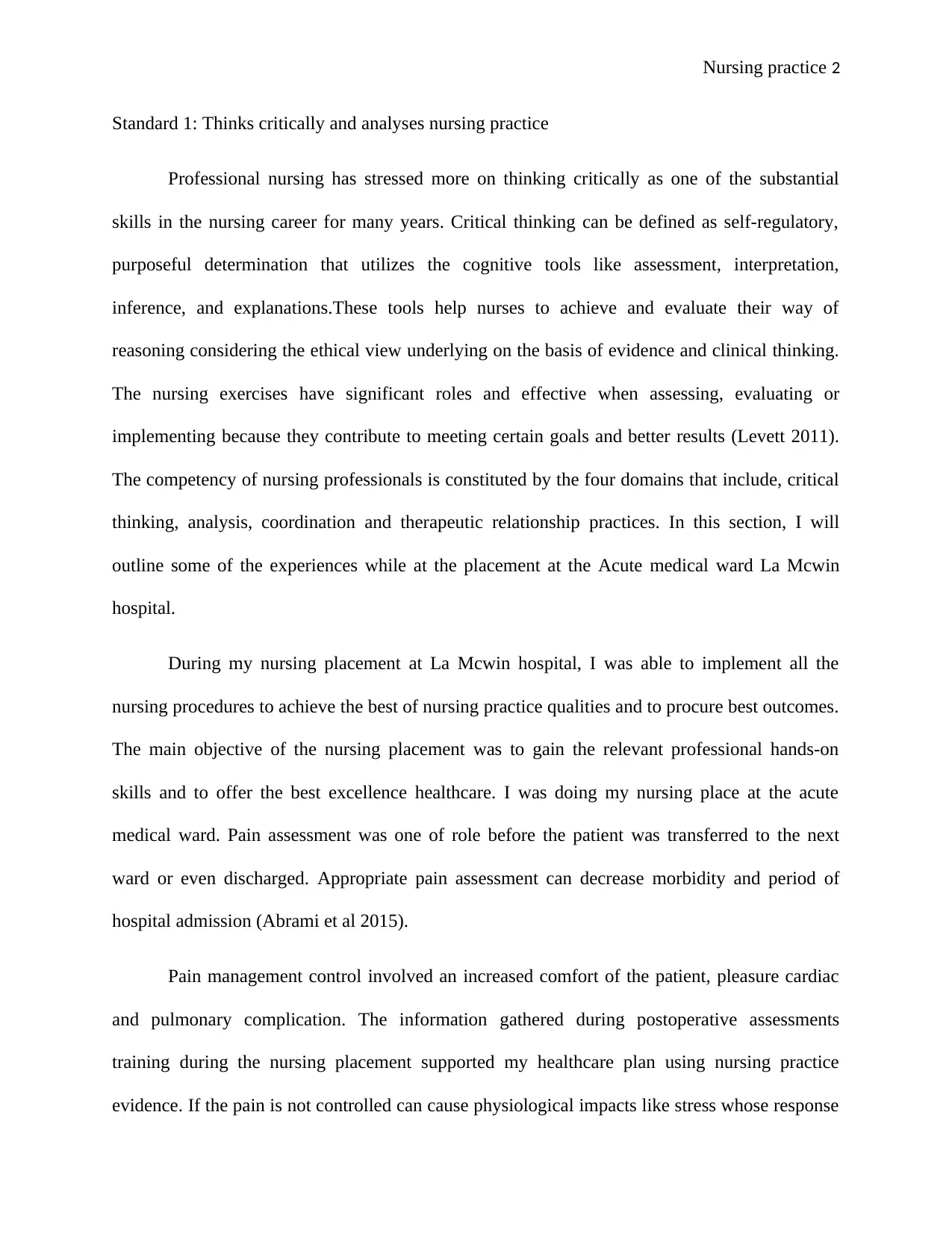
Nursing practice 2
Standard 1: Thinks critically and analyses nursing practice
Professional nursing has stressed more on thinking critically as one of the substantial
skills in the nursing career for many years. Critical thinking can be defined as self-regulatory,
purposeful determination that utilizes the cognitive tools like assessment, interpretation,
inference, and explanations.These tools help nurses to achieve and evaluate their way of
reasoning considering the ethical view underlying on the basis of evidence and clinical thinking.
The nursing exercises have significant roles and effective when assessing, evaluating or
implementing because they contribute to meeting certain goals and better results (Levett 2011).
The competency of nursing professionals is constituted by the four domains that include, critical
thinking, analysis, coordination and therapeutic relationship practices. In this section, I will
outline some of the experiences while at the placement at the Acute medical ward La Mcwin
hospital.
During my nursing placement at La Mcwin hospital, I was able to implement all the
nursing procedures to achieve the best of nursing practice qualities and to procure best outcomes.
The main objective of the nursing placement was to gain the relevant professional hands-on
skills and to offer the best excellence healthcare. I was doing my nursing place at the acute
medical ward. Pain assessment was one of role before the patient was transferred to the next
ward or even discharged. Appropriate pain assessment can decrease morbidity and period of
hospital admission (Abrami et al 2015).
Pain management control involved an increased comfort of the patient, pleasure cardiac
and pulmonary complication. The information gathered during postoperative assessments
training during the nursing placement supported my healthcare plan using nursing practice
evidence. If the pain is not controlled can cause physiological impacts like stress whose response
Standard 1: Thinks critically and analyses nursing practice
Professional nursing has stressed more on thinking critically as one of the substantial
skills in the nursing career for many years. Critical thinking can be defined as self-regulatory,
purposeful determination that utilizes the cognitive tools like assessment, interpretation,
inference, and explanations.These tools help nurses to achieve and evaluate their way of
reasoning considering the ethical view underlying on the basis of evidence and clinical thinking.
The nursing exercises have significant roles and effective when assessing, evaluating or
implementing because they contribute to meeting certain goals and better results (Levett 2011).
The competency of nursing professionals is constituted by the four domains that include, critical
thinking, analysis, coordination and therapeutic relationship practices. In this section, I will
outline some of the experiences while at the placement at the Acute medical ward La Mcwin
hospital.
During my nursing placement at La Mcwin hospital, I was able to implement all the
nursing procedures to achieve the best of nursing practice qualities and to procure best outcomes.
The main objective of the nursing placement was to gain the relevant professional hands-on
skills and to offer the best excellence healthcare. I was doing my nursing place at the acute
medical ward. Pain assessment was one of role before the patient was transferred to the next
ward or even discharged. Appropriate pain assessment can decrease morbidity and period of
hospital admission (Abrami et al 2015).
Pain management control involved an increased comfort of the patient, pleasure cardiac
and pulmonary complication. The information gathered during postoperative assessments
training during the nursing placement supported my healthcare plan using nursing practice
evidence. If the pain is not controlled can cause physiological impacts like stress whose response
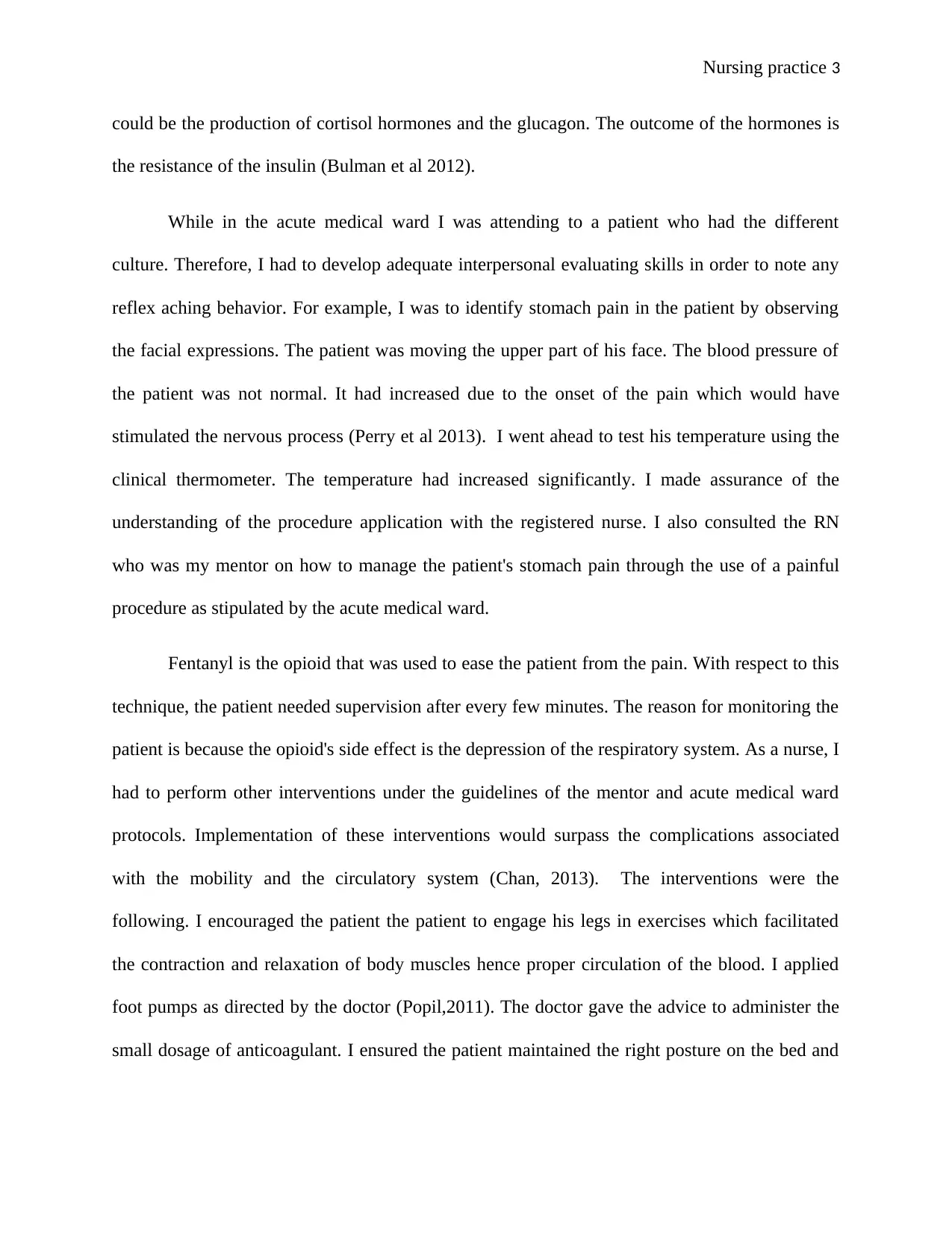
Nursing practice 3
could be the production of cortisol hormones and the glucagon. The outcome of the hormones is
the resistance of the insulin (Bulman et al 2012).
While in the acute medical ward I was attending to a patient who had the different
culture. Therefore, I had to develop adequate interpersonal evaluating skills in order to note any
reflex aching behavior. For example, I was to identify stomach pain in the patient by observing
the facial expressions. The patient was moving the upper part of his face. The blood pressure of
the patient was not normal. It had increased due to the onset of the pain which would have
stimulated the nervous process (Perry et al 2013). I went ahead to test his temperature using the
clinical thermometer. The temperature had increased significantly. I made assurance of the
understanding of the procedure application with the registered nurse. I also consulted the RN
who was my mentor on how to manage the patient's stomach pain through the use of a painful
procedure as stipulated by the acute medical ward.
Fentanyl is the opioid that was used to ease the patient from the pain. With respect to this
technique, the patient needed supervision after every few minutes. The reason for monitoring the
patient is because the opioid's side effect is the depression of the respiratory system. As a nurse, I
had to perform other interventions under the guidelines of the mentor and acute medical ward
protocols. Implementation of these interventions would surpass the complications associated
with the mobility and the circulatory system (Chan, 2013). The interventions were the
following. I encouraged the patient the patient to engage his legs in exercises which facilitated
the contraction and relaxation of body muscles hence proper circulation of the blood. I applied
foot pumps as directed by the doctor (Popil,2011). The doctor gave the advice to administer the
small dosage of anticoagulant. I ensured the patient maintained the right posture on the bed and
could be the production of cortisol hormones and the glucagon. The outcome of the hormones is
the resistance of the insulin (Bulman et al 2012).
While in the acute medical ward I was attending to a patient who had the different
culture. Therefore, I had to develop adequate interpersonal evaluating skills in order to note any
reflex aching behavior. For example, I was to identify stomach pain in the patient by observing
the facial expressions. The patient was moving the upper part of his face. The blood pressure of
the patient was not normal. It had increased due to the onset of the pain which would have
stimulated the nervous process (Perry et al 2013). I went ahead to test his temperature using the
clinical thermometer. The temperature had increased significantly. I made assurance of the
understanding of the procedure application with the registered nurse. I also consulted the RN
who was my mentor on how to manage the patient's stomach pain through the use of a painful
procedure as stipulated by the acute medical ward.
Fentanyl is the opioid that was used to ease the patient from the pain. With respect to this
technique, the patient needed supervision after every few minutes. The reason for monitoring the
patient is because the opioid's side effect is the depression of the respiratory system. As a nurse, I
had to perform other interventions under the guidelines of the mentor and acute medical ward
protocols. Implementation of these interventions would surpass the complications associated
with the mobility and the circulatory system (Chan, 2013). The interventions were the
following. I encouraged the patient the patient to engage his legs in exercises which facilitated
the contraction and relaxation of body muscles hence proper circulation of the blood. I applied
foot pumps as directed by the doctor (Popil,2011). The doctor gave the advice to administer the
small dosage of anticoagulant. I ensured the patient maintained the right posture on the bed and
⊘ This is a preview!⊘
Do you want full access?
Subscribe today to unlock all pages.

Trusted by 1+ million students worldwide
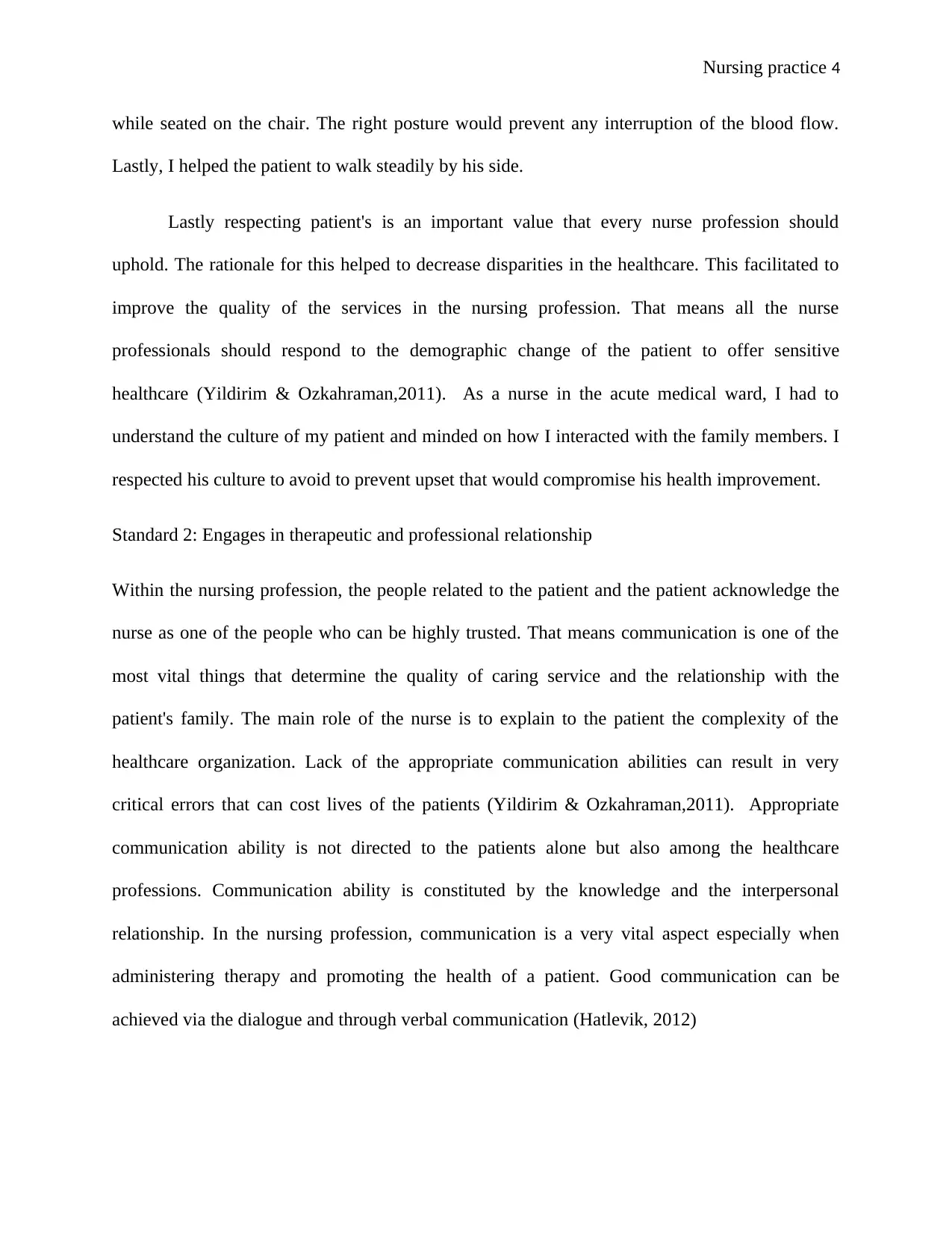
Nursing practice 4
while seated on the chair. The right posture would prevent any interruption of the blood flow.
Lastly, I helped the patient to walk steadily by his side.
Lastly respecting patient's is an important value that every nurse profession should
uphold. The rationale for this helped to decrease disparities in the healthcare. This facilitated to
improve the quality of the services in the nursing profession. That means all the nurse
professionals should respond to the demographic change of the patient to offer sensitive
healthcare (Yildirim & Ozkahraman,2011). As a nurse in the acute medical ward, I had to
understand the culture of my patient and minded on how I interacted with the family members. I
respected his culture to avoid to prevent upset that would compromise his health improvement.
Standard 2: Engages in therapeutic and professional relationship
Within the nursing profession, the people related to the patient and the patient acknowledge the
nurse as one of the people who can be highly trusted. That means communication is one of the
most vital things that determine the quality of caring service and the relationship with the
patient's family. The main role of the nurse is to explain to the patient the complexity of the
healthcare organization. Lack of the appropriate communication abilities can result in very
critical errors that can cost lives of the patients (Yildirim & Ozkahraman,2011). Appropriate
communication ability is not directed to the patients alone but also among the healthcare
professions. Communication ability is constituted by the knowledge and the interpersonal
relationship. In the nursing profession, communication is a very vital aspect especially when
administering therapy and promoting the health of a patient. Good communication can be
achieved via the dialogue and through verbal communication (Hatlevik, 2012)
while seated on the chair. The right posture would prevent any interruption of the blood flow.
Lastly, I helped the patient to walk steadily by his side.
Lastly respecting patient's is an important value that every nurse profession should
uphold. The rationale for this helped to decrease disparities in the healthcare. This facilitated to
improve the quality of the services in the nursing profession. That means all the nurse
professionals should respond to the demographic change of the patient to offer sensitive
healthcare (Yildirim & Ozkahraman,2011). As a nurse in the acute medical ward, I had to
understand the culture of my patient and minded on how I interacted with the family members. I
respected his culture to avoid to prevent upset that would compromise his health improvement.
Standard 2: Engages in therapeutic and professional relationship
Within the nursing profession, the people related to the patient and the patient acknowledge the
nurse as one of the people who can be highly trusted. That means communication is one of the
most vital things that determine the quality of caring service and the relationship with the
patient's family. The main role of the nurse is to explain to the patient the complexity of the
healthcare organization. Lack of the appropriate communication abilities can result in very
critical errors that can cost lives of the patients (Yildirim & Ozkahraman,2011). Appropriate
communication ability is not directed to the patients alone but also among the healthcare
professions. Communication ability is constituted by the knowledge and the interpersonal
relationship. In the nursing profession, communication is a very vital aspect especially when
administering therapy and promoting the health of a patient. Good communication can be
achieved via the dialogue and through verbal communication (Hatlevik, 2012)
Paraphrase This Document
Need a fresh take? Get an instant paraphrase of this document with our AI Paraphraser
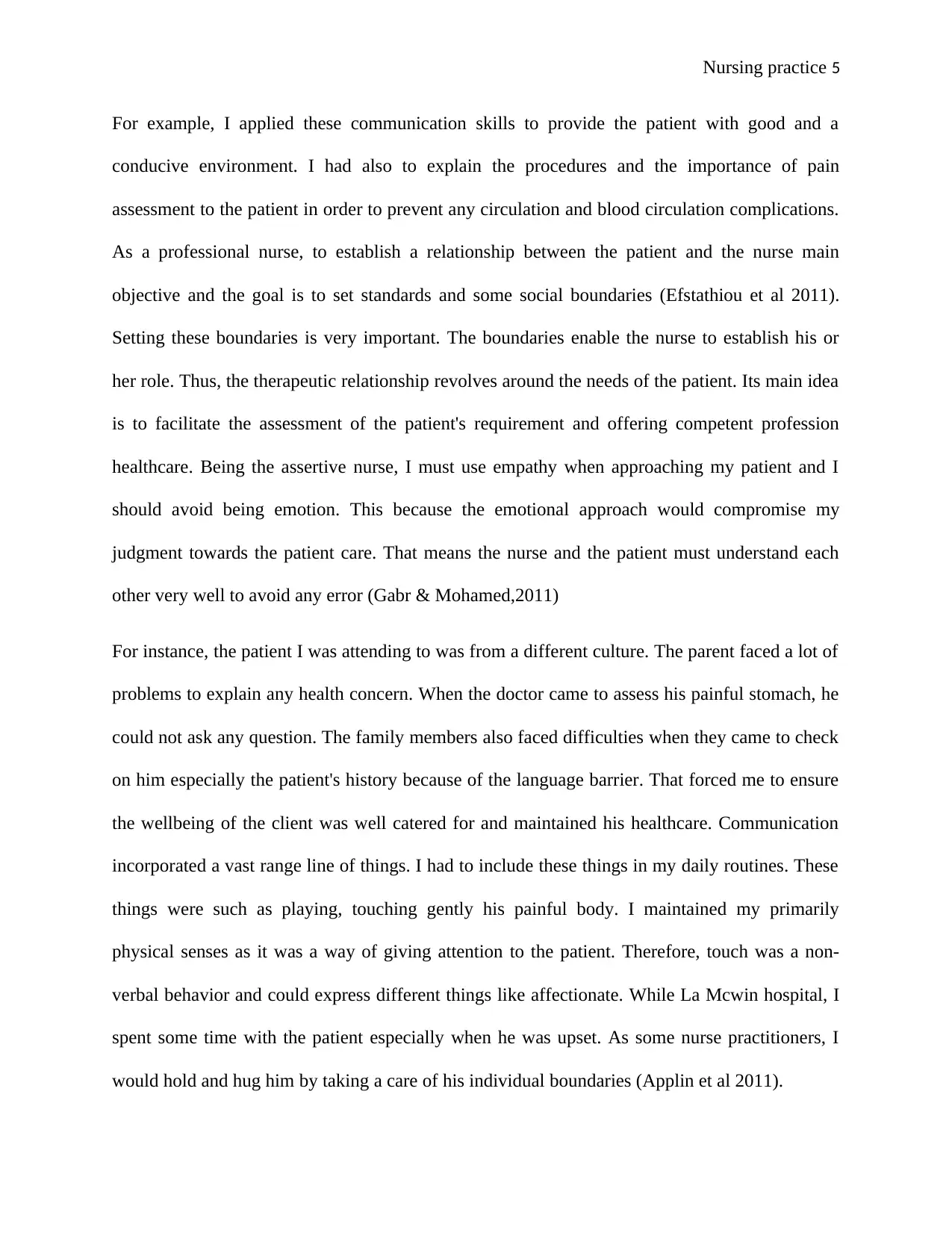
Nursing practice 5
For example, I applied these communication skills to provide the patient with good and a
conducive environment. I had also to explain the procedures and the importance of pain
assessment to the patient in order to prevent any circulation and blood circulation complications.
As a professional nurse, to establish a relationship between the patient and the nurse main
objective and the goal is to set standards and some social boundaries (Efstathiou et al 2011).
Setting these boundaries is very important. The boundaries enable the nurse to establish his or
her role. Thus, the therapeutic relationship revolves around the needs of the patient. Its main idea
is to facilitate the assessment of the patient's requirement and offering competent profession
healthcare. Being the assertive nurse, I must use empathy when approaching my patient and I
should avoid being emotion. This because the emotional approach would compromise my
judgment towards the patient care. That means the nurse and the patient must understand each
other very well to avoid any error (Gabr & Mohamed,2011)
For instance, the patient I was attending to was from a different culture. The parent faced a lot of
problems to explain any health concern. When the doctor came to assess his painful stomach, he
could not ask any question. The family members also faced difficulties when they came to check
on him especially the patient's history because of the language barrier. That forced me to ensure
the wellbeing of the client was well catered for and maintained his healthcare. Communication
incorporated a vast range line of things. I had to include these things in my daily routines. These
things were such as playing, touching gently his painful body. I maintained my primarily
physical senses as it was a way of giving attention to the patient. Therefore, touch was a non-
verbal behavior and could express different things like affectionate. While La Mcwin hospital, I
spent some time with the patient especially when he was upset. As some nurse practitioners, I
would hold and hug him by taking a care of his individual boundaries (Applin et al 2011).
For example, I applied these communication skills to provide the patient with good and a
conducive environment. I had also to explain the procedures and the importance of pain
assessment to the patient in order to prevent any circulation and blood circulation complications.
As a professional nurse, to establish a relationship between the patient and the nurse main
objective and the goal is to set standards and some social boundaries (Efstathiou et al 2011).
Setting these boundaries is very important. The boundaries enable the nurse to establish his or
her role. Thus, the therapeutic relationship revolves around the needs of the patient. Its main idea
is to facilitate the assessment of the patient's requirement and offering competent profession
healthcare. Being the assertive nurse, I must use empathy when approaching my patient and I
should avoid being emotion. This because the emotional approach would compromise my
judgment towards the patient care. That means the nurse and the patient must understand each
other very well to avoid any error (Gabr & Mohamed,2011)
For instance, the patient I was attending to was from a different culture. The parent faced a lot of
problems to explain any health concern. When the doctor came to assess his painful stomach, he
could not ask any question. The family members also faced difficulties when they came to check
on him especially the patient's history because of the language barrier. That forced me to ensure
the wellbeing of the client was well catered for and maintained his healthcare. Communication
incorporated a vast range line of things. I had to include these things in my daily routines. These
things were such as playing, touching gently his painful body. I maintained my primarily
physical senses as it was a way of giving attention to the patient. Therefore, touch was a non-
verbal behavior and could express different things like affectionate. While La Mcwin hospital, I
spent some time with the patient especially when he was upset. As some nurse practitioners, I
would hold and hug him by taking a care of his individual boundaries (Applin et al 2011).
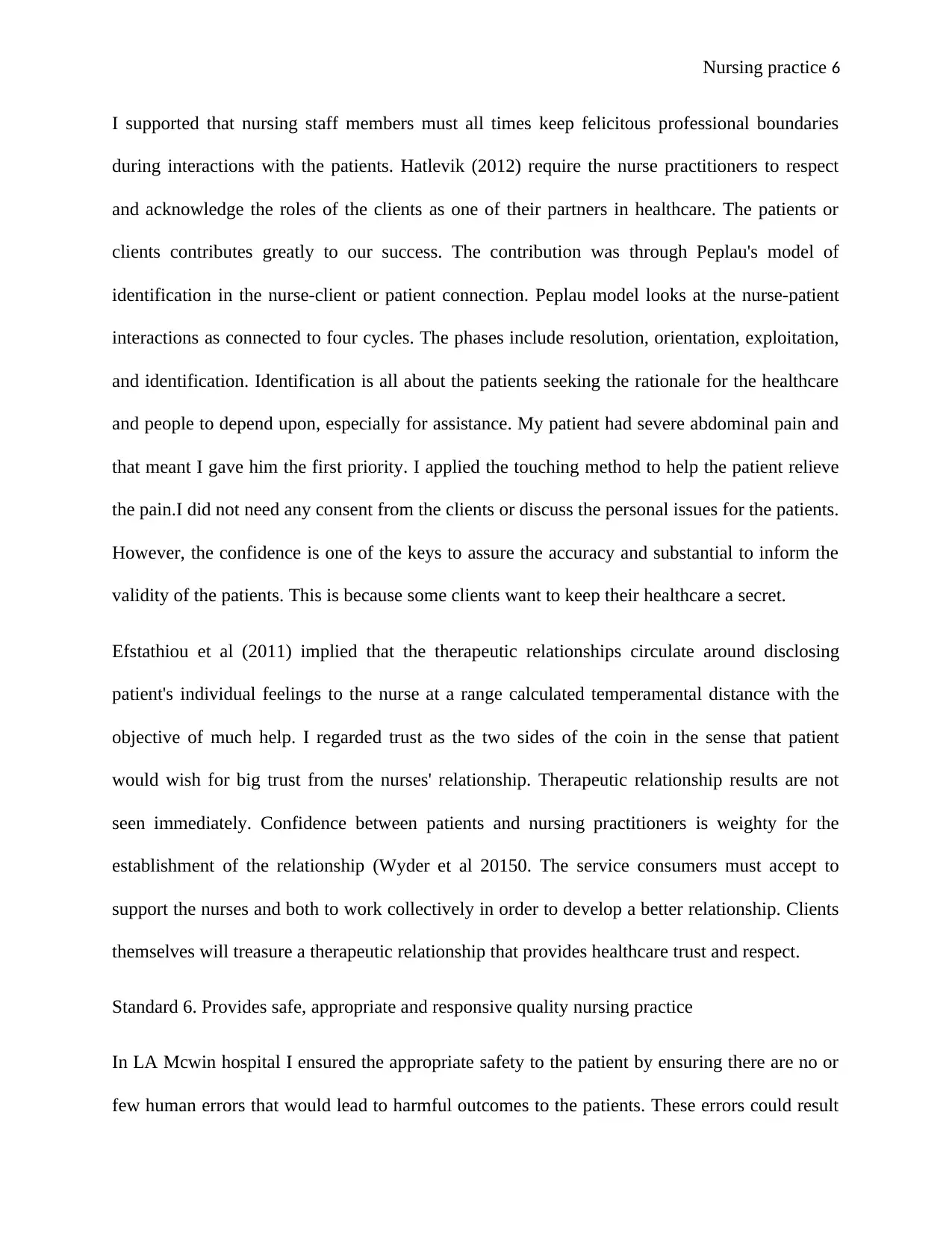
Nursing practice 6
I supported that nursing staff members must all times keep felicitous professional boundaries
during interactions with the patients. Hatlevik (2012) require the nurse practitioners to respect
and acknowledge the roles of the clients as one of their partners in healthcare. The patients or
clients contributes greatly to our success. The contribution was through Peplau's model of
identification in the nurse-client or patient connection. Peplau model looks at the nurse-patient
interactions as connected to four cycles. The phases include resolution, orientation, exploitation,
and identification. Identification is all about the patients seeking the rationale for the healthcare
and people to depend upon, especially for assistance. My patient had severe abdominal pain and
that meant I gave him the first priority. I applied the touching method to help the patient relieve
the pain.I did not need any consent from the clients or discuss the personal issues for the patients.
However, the confidence is one of the keys to assure the accuracy and substantial to inform the
validity of the patients. This is because some clients want to keep their healthcare a secret.
Efstathiou et al (2011) implied that the therapeutic relationships circulate around disclosing
patient's individual feelings to the nurse at a range calculated temperamental distance with the
objective of much help. I regarded trust as the two sides of the coin in the sense that patient
would wish for big trust from the nurses' relationship. Therapeutic relationship results are not
seen immediately. Confidence between patients and nursing practitioners is weighty for the
establishment of the relationship (Wyder et al 20150. The service consumers must accept to
support the nurses and both to work collectively in order to develop a better relationship. Clients
themselves will treasure a therapeutic relationship that provides healthcare trust and respect.
Standard 6. Provides safe, appropriate and responsive quality nursing practice
In LA Mcwin hospital I ensured the appropriate safety to the patient by ensuring there are no or
few human errors that would lead to harmful outcomes to the patients. These errors could result
I supported that nursing staff members must all times keep felicitous professional boundaries
during interactions with the patients. Hatlevik (2012) require the nurse practitioners to respect
and acknowledge the roles of the clients as one of their partners in healthcare. The patients or
clients contributes greatly to our success. The contribution was through Peplau's model of
identification in the nurse-client or patient connection. Peplau model looks at the nurse-patient
interactions as connected to four cycles. The phases include resolution, orientation, exploitation,
and identification. Identification is all about the patients seeking the rationale for the healthcare
and people to depend upon, especially for assistance. My patient had severe abdominal pain and
that meant I gave him the first priority. I applied the touching method to help the patient relieve
the pain.I did not need any consent from the clients or discuss the personal issues for the patients.
However, the confidence is one of the keys to assure the accuracy and substantial to inform the
validity of the patients. This is because some clients want to keep their healthcare a secret.
Efstathiou et al (2011) implied that the therapeutic relationships circulate around disclosing
patient's individual feelings to the nurse at a range calculated temperamental distance with the
objective of much help. I regarded trust as the two sides of the coin in the sense that patient
would wish for big trust from the nurses' relationship. Therapeutic relationship results are not
seen immediately. Confidence between patients and nursing practitioners is weighty for the
establishment of the relationship (Wyder et al 20150. The service consumers must accept to
support the nurses and both to work collectively in order to develop a better relationship. Clients
themselves will treasure a therapeutic relationship that provides healthcare trust and respect.
Standard 6. Provides safe, appropriate and responsive quality nursing practice
In LA Mcwin hospital I ensured the appropriate safety to the patient by ensuring there are no or
few human errors that would lead to harmful outcomes to the patients. These errors could result
⊘ This is a preview!⊘
Do you want full access?
Subscribe today to unlock all pages.

Trusted by 1+ million students worldwide
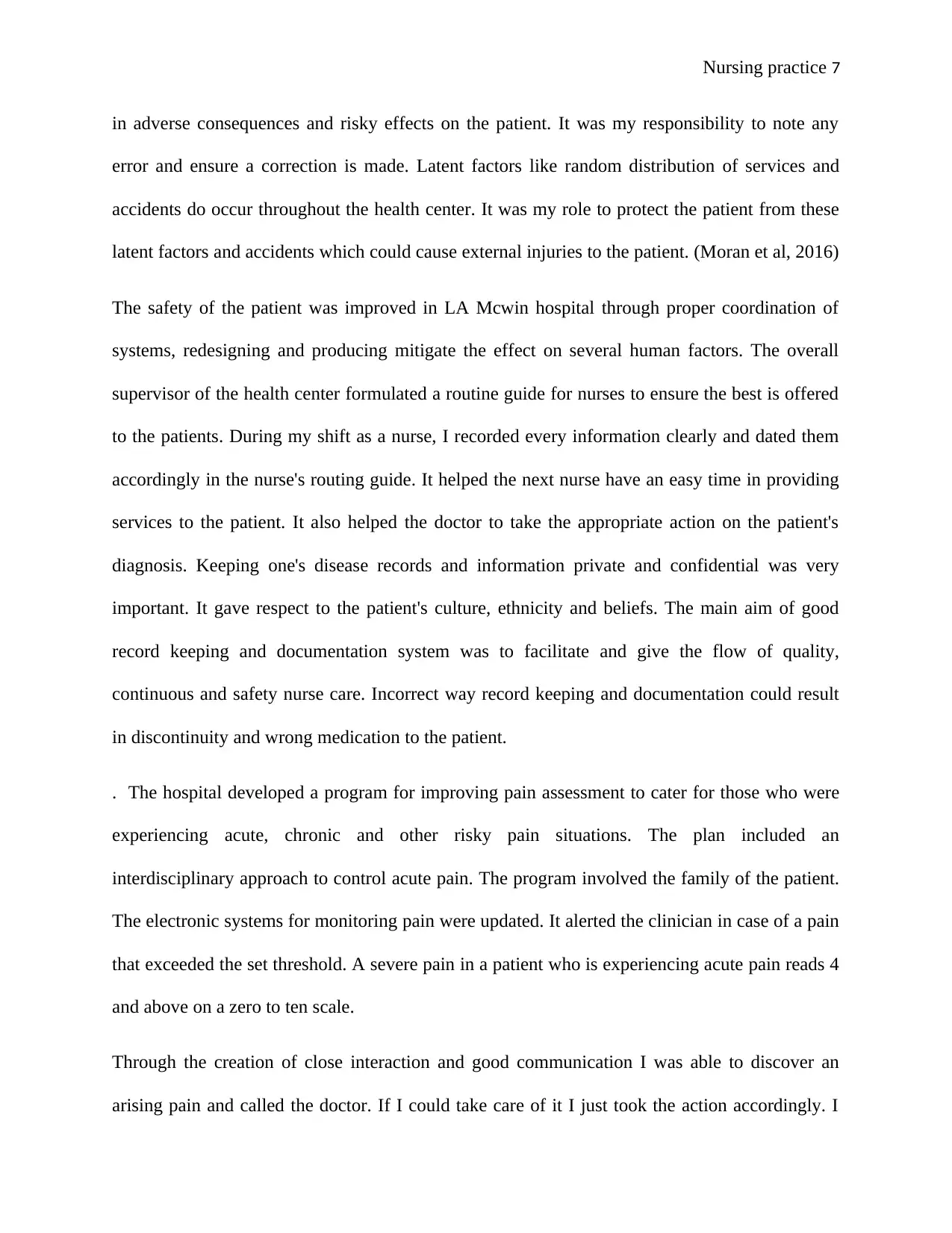
Nursing practice 7
in adverse consequences and risky effects on the patient. It was my responsibility to note any
error and ensure a correction is made. Latent factors like random distribution of services and
accidents do occur throughout the health center. It was my role to protect the patient from these
latent factors and accidents which could cause external injuries to the patient. (Moran et al, 2016)
The safety of the patient was improved in LA Mcwin hospital through proper coordination of
systems, redesigning and producing mitigate the effect on several human factors. The overall
supervisor of the health center formulated a routine guide for nurses to ensure the best is offered
to the patients. During my shift as a nurse, I recorded every information clearly and dated them
accordingly in the nurse's routing guide. It helped the next nurse have an easy time in providing
services to the patient. It also helped the doctor to take the appropriate action on the patient's
diagnosis. Keeping one's disease records and information private and confidential was very
important. It gave respect to the patient's culture, ethnicity and beliefs. The main aim of good
record keeping and documentation system was to facilitate and give the flow of quality,
continuous and safety nurse care. Incorrect way record keeping and documentation could result
in discontinuity and wrong medication to the patient.
. The hospital developed a program for improving pain assessment to cater for those who were
experiencing acute, chronic and other risky pain situations. The plan included an
interdisciplinary approach to control acute pain. The program involved the family of the patient.
The electronic systems for monitoring pain were updated. It alerted the clinician in case of a pain
that exceeded the set threshold. A severe pain in a patient who is experiencing acute pain reads 4
and above on a zero to ten scale.
Through the creation of close interaction and good communication I was able to discover an
arising pain and called the doctor. If I could take care of it I just took the action accordingly. I
in adverse consequences and risky effects on the patient. It was my responsibility to note any
error and ensure a correction is made. Latent factors like random distribution of services and
accidents do occur throughout the health center. It was my role to protect the patient from these
latent factors and accidents which could cause external injuries to the patient. (Moran et al, 2016)
The safety of the patient was improved in LA Mcwin hospital through proper coordination of
systems, redesigning and producing mitigate the effect on several human factors. The overall
supervisor of the health center formulated a routine guide for nurses to ensure the best is offered
to the patients. During my shift as a nurse, I recorded every information clearly and dated them
accordingly in the nurse's routing guide. It helped the next nurse have an easy time in providing
services to the patient. It also helped the doctor to take the appropriate action on the patient's
diagnosis. Keeping one's disease records and information private and confidential was very
important. It gave respect to the patient's culture, ethnicity and beliefs. The main aim of good
record keeping and documentation system was to facilitate and give the flow of quality,
continuous and safety nurse care. Incorrect way record keeping and documentation could result
in discontinuity and wrong medication to the patient.
. The hospital developed a program for improving pain assessment to cater for those who were
experiencing acute, chronic and other risky pain situations. The plan included an
interdisciplinary approach to control acute pain. The program involved the family of the patient.
The electronic systems for monitoring pain were updated. It alerted the clinician in case of a pain
that exceeded the set threshold. A severe pain in a patient who is experiencing acute pain reads 4
and above on a zero to ten scale.
Through the creation of close interaction and good communication I was able to discover an
arising pain and called the doctor. If I could take care of it I just took the action accordingly. I
Paraphrase This Document
Need a fresh take? Get an instant paraphrase of this document with our AI Paraphraser
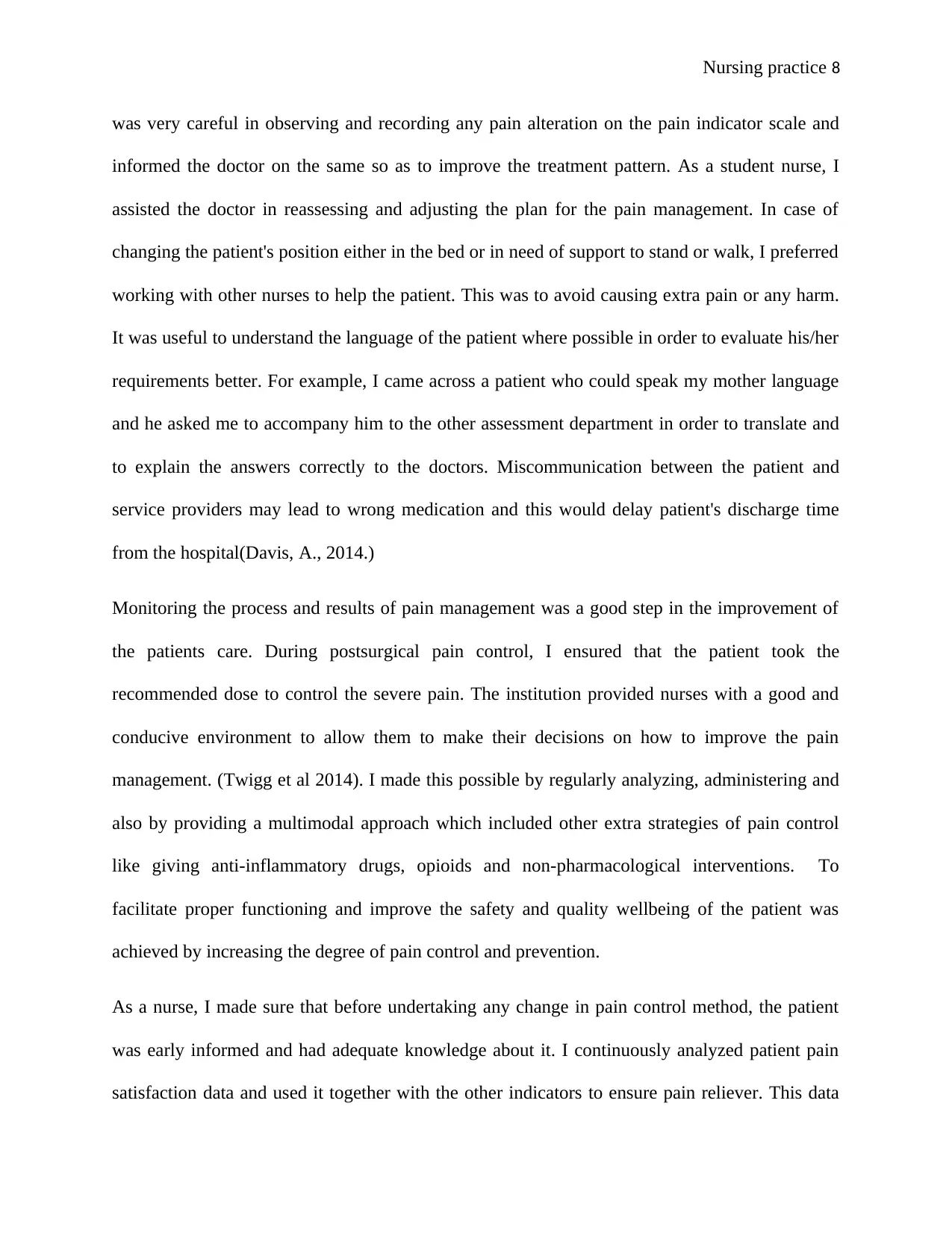
Nursing practice 8
was very careful in observing and recording any pain alteration on the pain indicator scale and
informed the doctor on the same so as to improve the treatment pattern. As a student nurse, I
assisted the doctor in reassessing and adjusting the plan for the pain management. In case of
changing the patient's position either in the bed or in need of support to stand or walk, I preferred
working with other nurses to help the patient. This was to avoid causing extra pain or any harm.
It was useful to understand the language of the patient where possible in order to evaluate his/her
requirements better. For example, I came across a patient who could speak my mother language
and he asked me to accompany him to the other assessment department in order to translate and
to explain the answers correctly to the doctors. Miscommunication between the patient and
service providers may lead to wrong medication and this would delay patient's discharge time
from the hospital(Davis, A., 2014.)
Monitoring the process and results of pain management was a good step in the improvement of
the patients care. During postsurgical pain control, I ensured that the patient took the
recommended dose to control the severe pain. The institution provided nurses with a good and
conducive environment to allow them to make their decisions on how to improve the pain
management. (Twigg et al 2014). I made this possible by regularly analyzing, administering and
also by providing a multimodal approach which included other extra strategies of pain control
like giving anti-inflammatory drugs, opioids and non-pharmacological interventions. To
facilitate proper functioning and improve the safety and quality wellbeing of the patient was
achieved by increasing the degree of pain control and prevention.
As a nurse, I made sure that before undertaking any change in pain control method, the patient
was early informed and had adequate knowledge about it. I continuously analyzed patient pain
satisfaction data and used it together with the other indicators to ensure pain reliever. This data
was very careful in observing and recording any pain alteration on the pain indicator scale and
informed the doctor on the same so as to improve the treatment pattern. As a student nurse, I
assisted the doctor in reassessing and adjusting the plan for the pain management. In case of
changing the patient's position either in the bed or in need of support to stand or walk, I preferred
working with other nurses to help the patient. This was to avoid causing extra pain or any harm.
It was useful to understand the language of the patient where possible in order to evaluate his/her
requirements better. For example, I came across a patient who could speak my mother language
and he asked me to accompany him to the other assessment department in order to translate and
to explain the answers correctly to the doctors. Miscommunication between the patient and
service providers may lead to wrong medication and this would delay patient's discharge time
from the hospital(Davis, A., 2014.)
Monitoring the process and results of pain management was a good step in the improvement of
the patients care. During postsurgical pain control, I ensured that the patient took the
recommended dose to control the severe pain. The institution provided nurses with a good and
conducive environment to allow them to make their decisions on how to improve the pain
management. (Twigg et al 2014). I made this possible by regularly analyzing, administering and
also by providing a multimodal approach which included other extra strategies of pain control
like giving anti-inflammatory drugs, opioids and non-pharmacological interventions. To
facilitate proper functioning and improve the safety and quality wellbeing of the patient was
achieved by increasing the degree of pain control and prevention.
As a nurse, I made sure that before undertaking any change in pain control method, the patient
was early informed and had adequate knowledge about it. I continuously analyzed patient pain
satisfaction data and used it together with the other indicators to ensure pain reliever. This data
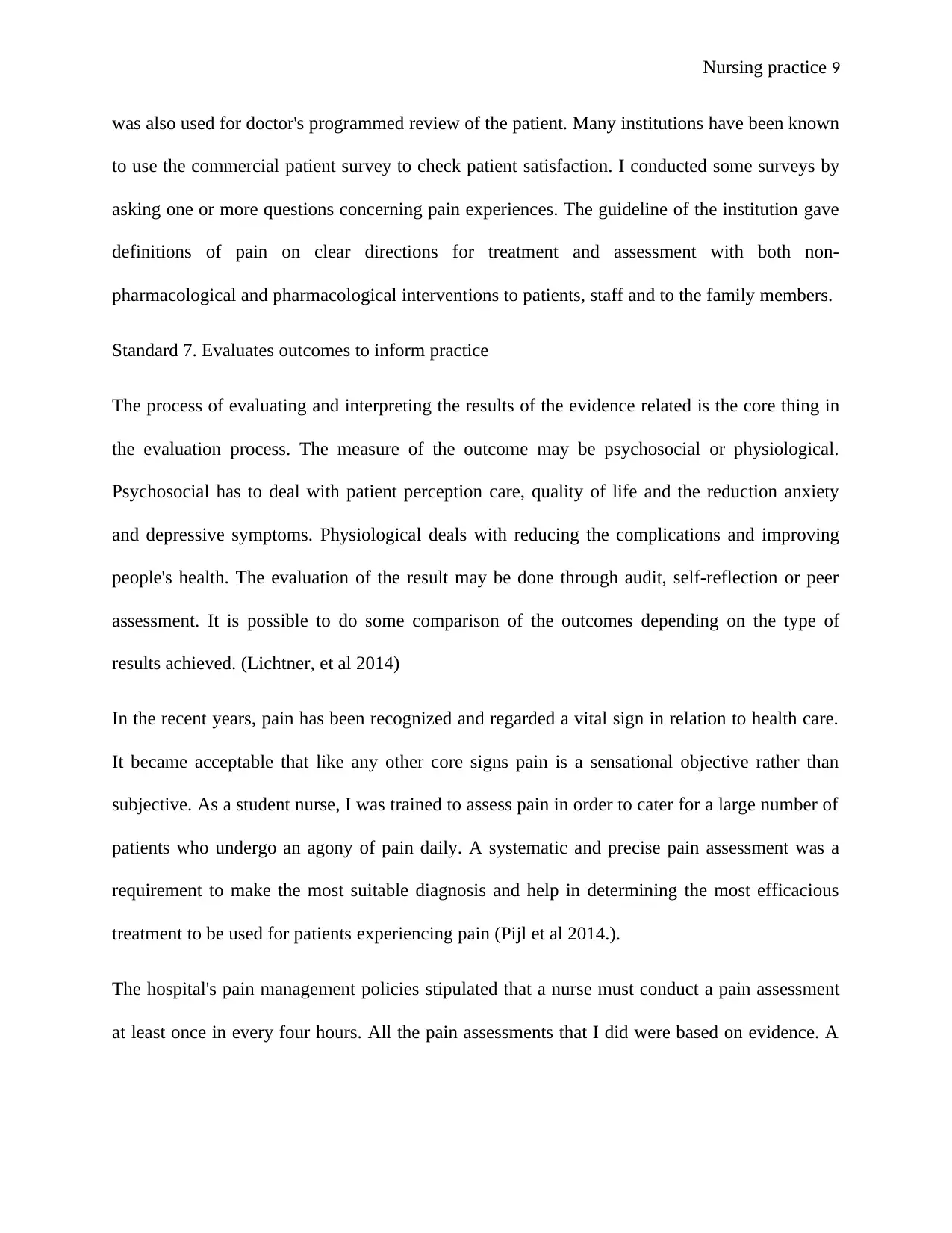
Nursing practice 9
was also used for doctor's programmed review of the patient. Many institutions have been known
to use the commercial patient survey to check patient satisfaction. I conducted some surveys by
asking one or more questions concerning pain experiences. The guideline of the institution gave
definitions of pain on clear directions for treatment and assessment with both non-
pharmacological and pharmacological interventions to patients, staff and to the family members.
Standard 7. Evaluates outcomes to inform practice
The process of evaluating and interpreting the results of the evidence related is the core thing in
the evaluation process. The measure of the outcome may be psychosocial or physiological.
Psychosocial has to deal with patient perception care, quality of life and the reduction anxiety
and depressive symptoms. Physiological deals with reducing the complications and improving
people's health. The evaluation of the result may be done through audit, self-reflection or peer
assessment. It is possible to do some comparison of the outcomes depending on the type of
results achieved. (Lichtner, et al 2014)
In the recent years, pain has been recognized and regarded a vital sign in relation to health care.
It became acceptable that like any other core signs pain is a sensational objective rather than
subjective. As a student nurse, I was trained to assess pain in order to cater for a large number of
patients who undergo an agony of pain daily. A systematic and precise pain assessment was a
requirement to make the most suitable diagnosis and help in determining the most efficacious
treatment to be used for patients experiencing pain (Pijl et al 2014.).
The hospital's pain management policies stipulated that a nurse must conduct a pain assessment
at least once in every four hours. All the pain assessments that I did were based on evidence. A
was also used for doctor's programmed review of the patient. Many institutions have been known
to use the commercial patient survey to check patient satisfaction. I conducted some surveys by
asking one or more questions concerning pain experiences. The guideline of the institution gave
definitions of pain on clear directions for treatment and assessment with both non-
pharmacological and pharmacological interventions to patients, staff and to the family members.
Standard 7. Evaluates outcomes to inform practice
The process of evaluating and interpreting the results of the evidence related is the core thing in
the evaluation process. The measure of the outcome may be psychosocial or physiological.
Psychosocial has to deal with patient perception care, quality of life and the reduction anxiety
and depressive symptoms. Physiological deals with reducing the complications and improving
people's health. The evaluation of the result may be done through audit, self-reflection or peer
assessment. It is possible to do some comparison of the outcomes depending on the type of
results achieved. (Lichtner, et al 2014)
In the recent years, pain has been recognized and regarded a vital sign in relation to health care.
It became acceptable that like any other core signs pain is a sensational objective rather than
subjective. As a student nurse, I was trained to assess pain in order to cater for a large number of
patients who undergo an agony of pain daily. A systematic and precise pain assessment was a
requirement to make the most suitable diagnosis and help in determining the most efficacious
treatment to be used for patients experiencing pain (Pijl et al 2014.).
The hospital's pain management policies stipulated that a nurse must conduct a pain assessment
at least once in every four hours. All the pain assessments that I did were based on evidence. A
⊘ This is a preview!⊘
Do you want full access?
Subscribe today to unlock all pages.

Trusted by 1+ million students worldwide
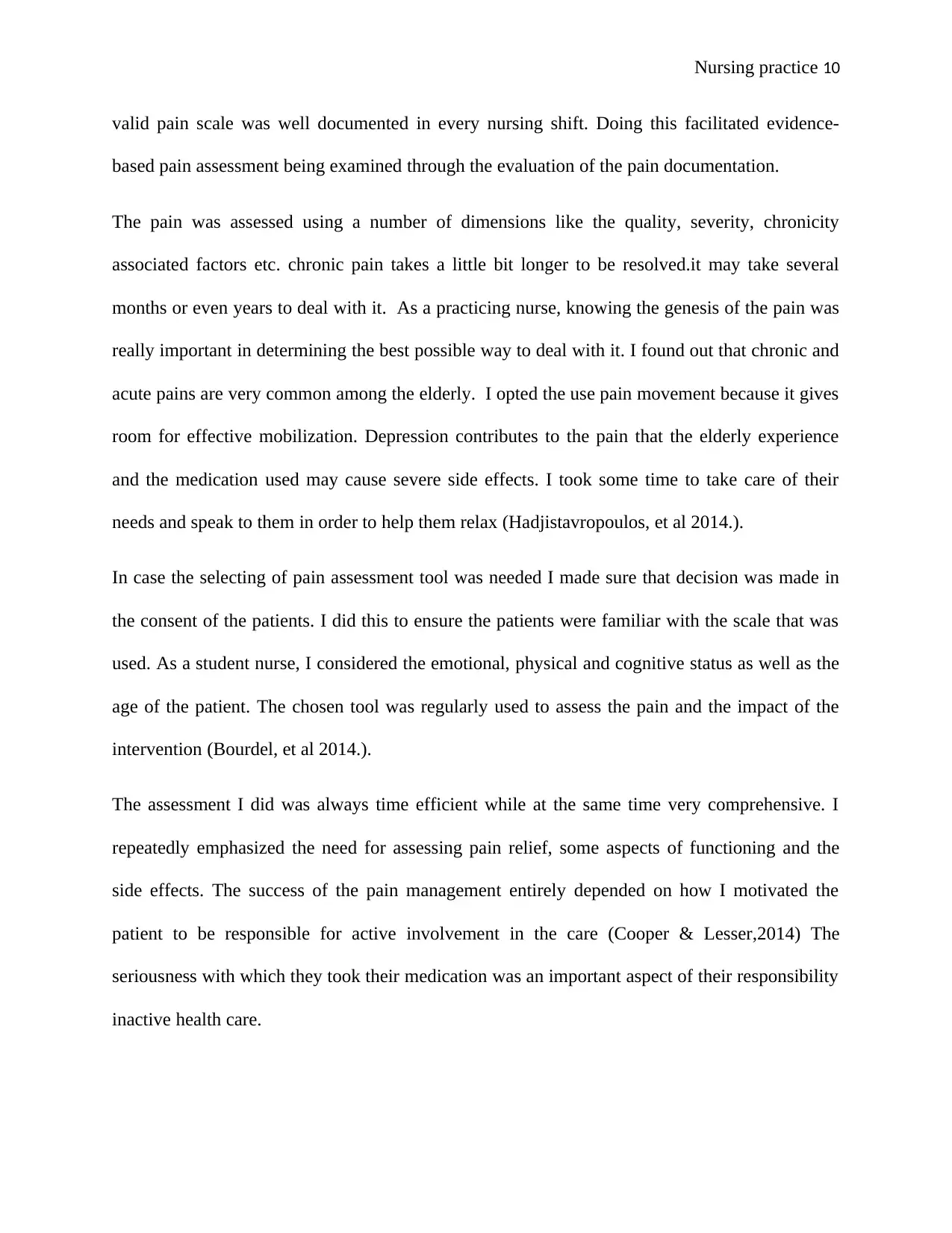
Nursing practice 10
valid pain scale was well documented in every nursing shift. Doing this facilitated evidence-
based pain assessment being examined through the evaluation of the pain documentation.
The pain was assessed using a number of dimensions like the quality, severity, chronicity
associated factors etc. chronic pain takes a little bit longer to be resolved.it may take several
months or even years to deal with it. As a practicing nurse, knowing the genesis of the pain was
really important in determining the best possible way to deal with it. I found out that chronic and
acute pains are very common among the elderly. I opted the use pain movement because it gives
room for effective mobilization. Depression contributes to the pain that the elderly experience
and the medication used may cause severe side effects. I took some time to take care of their
needs and speak to them in order to help them relax (Hadjistavropoulos, et al 2014.).
In case the selecting of pain assessment tool was needed I made sure that decision was made in
the consent of the patients. I did this to ensure the patients were familiar with the scale that was
used. As a student nurse, I considered the emotional, physical and cognitive status as well as the
age of the patient. The chosen tool was regularly used to assess the pain and the impact of the
intervention (Bourdel, et al 2014.).
The assessment I did was always time efficient while at the same time very comprehensive. I
repeatedly emphasized the need for assessing pain relief, some aspects of functioning and the
side effects. The success of the pain management entirely depended on how I motivated the
patient to be responsible for active involvement in the care (Cooper & Lesser,2014) The
seriousness with which they took their medication was an important aspect of their responsibility
inactive health care.
valid pain scale was well documented in every nursing shift. Doing this facilitated evidence-
based pain assessment being examined through the evaluation of the pain documentation.
The pain was assessed using a number of dimensions like the quality, severity, chronicity
associated factors etc. chronic pain takes a little bit longer to be resolved.it may take several
months or even years to deal with it. As a practicing nurse, knowing the genesis of the pain was
really important in determining the best possible way to deal with it. I found out that chronic and
acute pains are very common among the elderly. I opted the use pain movement because it gives
room for effective mobilization. Depression contributes to the pain that the elderly experience
and the medication used may cause severe side effects. I took some time to take care of their
needs and speak to them in order to help them relax (Hadjistavropoulos, et al 2014.).
In case the selecting of pain assessment tool was needed I made sure that decision was made in
the consent of the patients. I did this to ensure the patients were familiar with the scale that was
used. As a student nurse, I considered the emotional, physical and cognitive status as well as the
age of the patient. The chosen tool was regularly used to assess the pain and the impact of the
intervention (Bourdel, et al 2014.).
The assessment I did was always time efficient while at the same time very comprehensive. I
repeatedly emphasized the need for assessing pain relief, some aspects of functioning and the
side effects. The success of the pain management entirely depended on how I motivated the
patient to be responsible for active involvement in the care (Cooper & Lesser,2014) The
seriousness with which they took their medication was an important aspect of their responsibility
inactive health care.
Paraphrase This Document
Need a fresh take? Get an instant paraphrase of this document with our AI Paraphraser
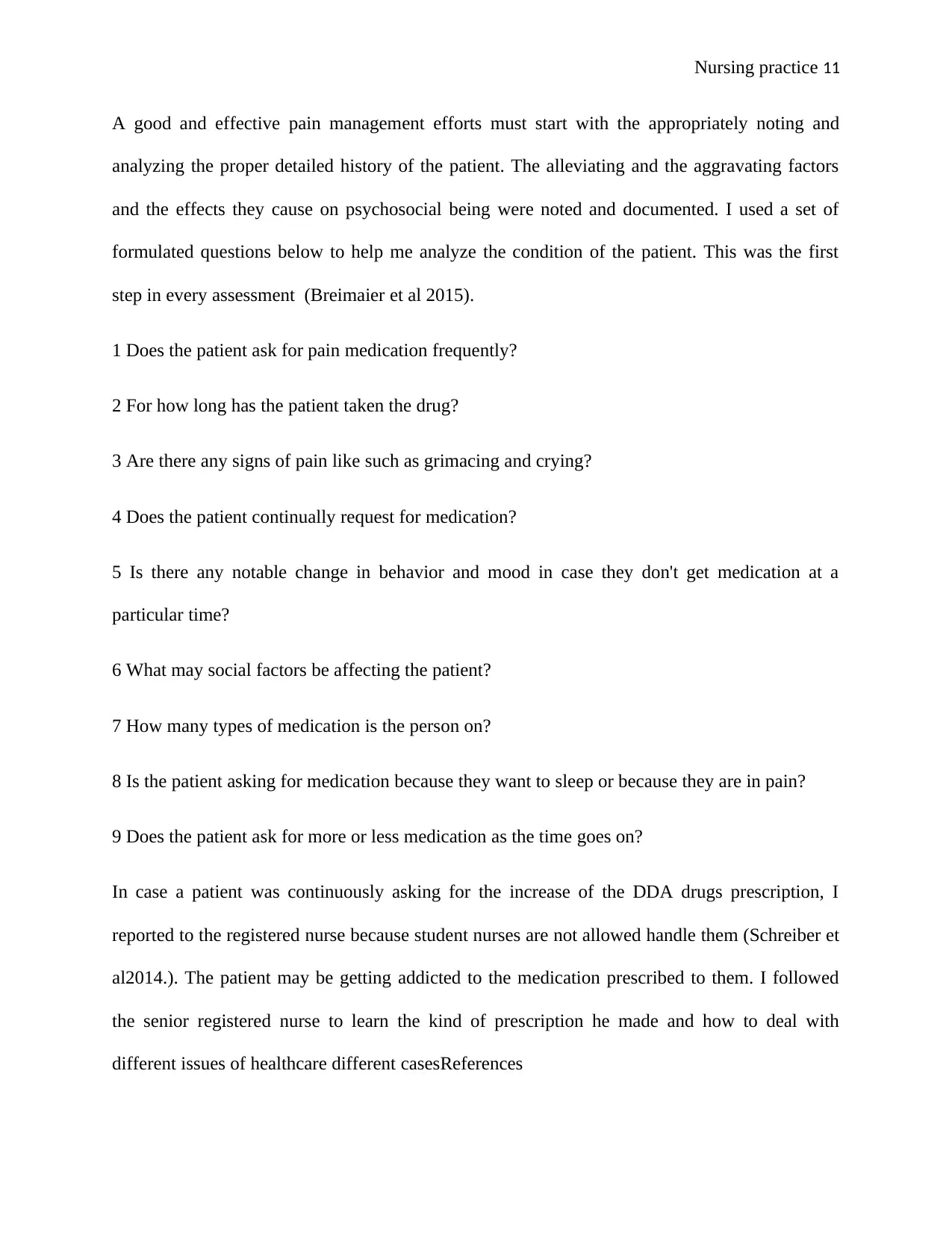
Nursing practice 11
A good and effective pain management efforts must start with the appropriately noting and
analyzing the proper detailed history of the patient. The alleviating and the aggravating factors
and the effects they cause on psychosocial being were noted and documented. I used a set of
formulated questions below to help me analyze the condition of the patient. This was the first
step in every assessment (Breimaier et al 2015).
1 Does the patient ask for pain medication frequently?
2 For how long has the patient taken the drug?
3 Are there any signs of pain like such as grimacing and crying?
4 Does the patient continually request for medication?
5 Is there any notable change in behavior and mood in case they don't get medication at a
particular time?
6 What may social factors be affecting the patient?
7 How many types of medication is the person on?
8 Is the patient asking for medication because they want to sleep or because they are in pain?
9 Does the patient ask for more or less medication as the time goes on?
In case a patient was continuously asking for the increase of the DDA drugs prescription, I
reported to the registered nurse because student nurses are not allowed handle them (Schreiber et
al2014.). The patient may be getting addicted to the medication prescribed to them. I followed
the senior registered nurse to learn the kind of prescription he made and how to deal with
different issues of healthcare different casesReferences
A good and effective pain management efforts must start with the appropriately noting and
analyzing the proper detailed history of the patient. The alleviating and the aggravating factors
and the effects they cause on psychosocial being were noted and documented. I used a set of
formulated questions below to help me analyze the condition of the patient. This was the first
step in every assessment (Breimaier et al 2015).
1 Does the patient ask for pain medication frequently?
2 For how long has the patient taken the drug?
3 Are there any signs of pain like such as grimacing and crying?
4 Does the patient continually request for medication?
5 Is there any notable change in behavior and mood in case they don't get medication at a
particular time?
6 What may social factors be affecting the patient?
7 How many types of medication is the person on?
8 Is the patient asking for medication because they want to sleep or because they are in pain?
9 Does the patient ask for more or less medication as the time goes on?
In case a patient was continuously asking for the increase of the DDA drugs prescription, I
reported to the registered nurse because student nurses are not allowed handle them (Schreiber et
al2014.). The patient may be getting addicted to the medication prescribed to them. I followed
the senior registered nurse to learn the kind of prescription he made and how to deal with
different issues of healthcare different casesReferences
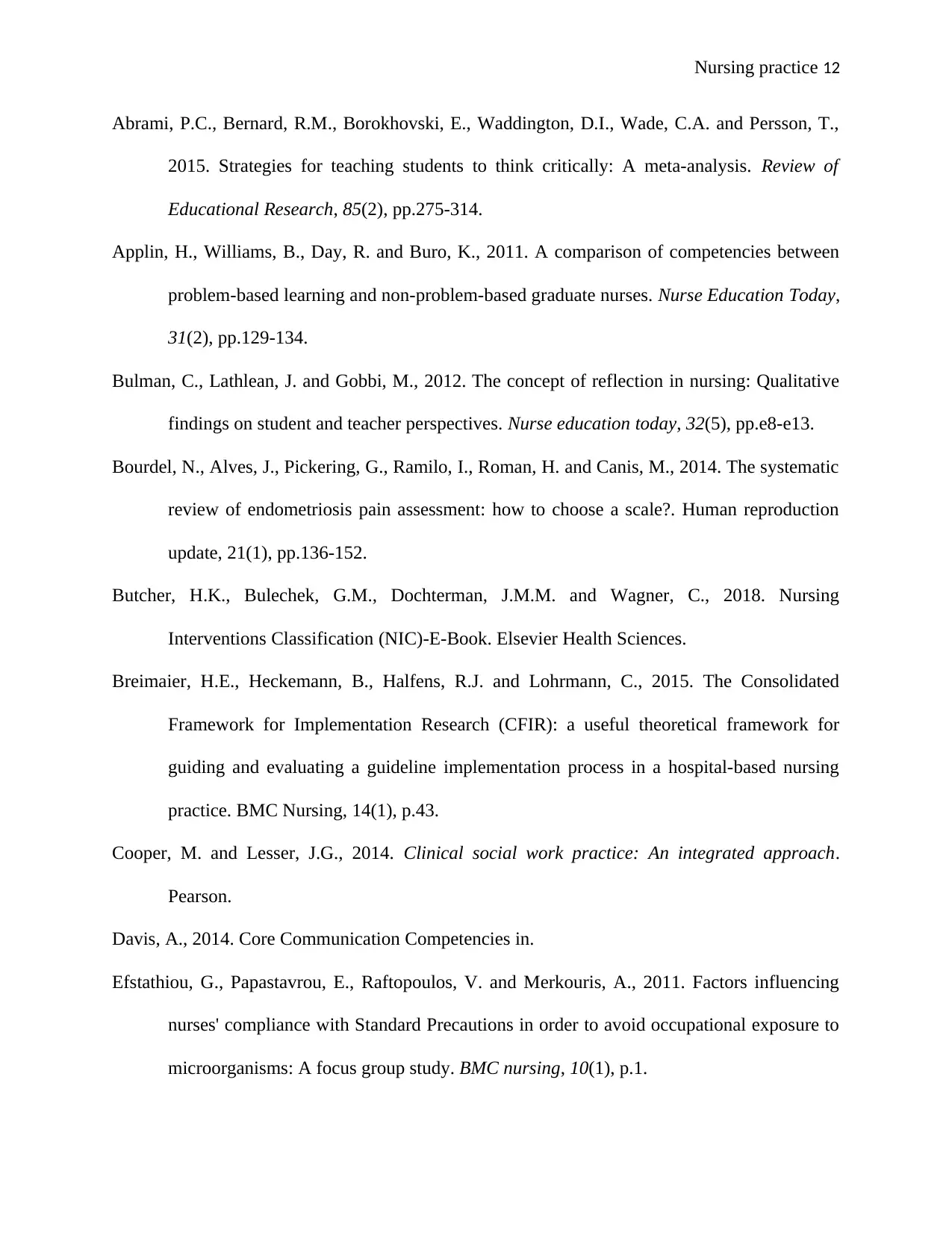
Nursing practice 12
Abrami, P.C., Bernard, R.M., Borokhovski, E., Waddington, D.I., Wade, C.A. and Persson, T.,
2015. Strategies for teaching students to think critically: A meta-analysis. Review of
Educational Research, 85(2), pp.275-314.
Applin, H., Williams, B., Day, R. and Buro, K., 2011. A comparison of competencies between
problem-based learning and non-problem-based graduate nurses. Nurse Education Today,
31(2), pp.129-134.
Bulman, C., Lathlean, J. and Gobbi, M., 2012. The concept of reflection in nursing: Qualitative
findings on student and teacher perspectives. Nurse education today, 32(5), pp.e8-e13.
Bourdel, N., Alves, J., Pickering, G., Ramilo, I., Roman, H. and Canis, M., 2014. The systematic
review of endometriosis pain assessment: how to choose a scale?. Human reproduction
update, 21(1), pp.136-152.
Butcher, H.K., Bulechek, G.M., Dochterman, J.M.M. and Wagner, C., 2018. Nursing
Interventions Classification (NIC)-E-Book. Elsevier Health Sciences.
Breimaier, H.E., Heckemann, B., Halfens, R.J. and Lohrmann, C., 2015. The Consolidated
Framework for Implementation Research (CFIR): a useful theoretical framework for
guiding and evaluating a guideline implementation process in a hospital-based nursing
practice. BMC Nursing, 14(1), p.43.
Cooper, M. and Lesser, J.G., 2014. Clinical social work practice: An integrated approach.
Pearson.
Davis, A., 2014. Core Communication Competencies in.
Efstathiou, G., Papastavrou, E., Raftopoulos, V. and Merkouris, A., 2011. Factors influencing
nurses' compliance with Standard Precautions in order to avoid occupational exposure to
microorganisms: A focus group study. BMC nursing, 10(1), p.1.
Abrami, P.C., Bernard, R.M., Borokhovski, E., Waddington, D.I., Wade, C.A. and Persson, T.,
2015. Strategies for teaching students to think critically: A meta-analysis. Review of
Educational Research, 85(2), pp.275-314.
Applin, H., Williams, B., Day, R. and Buro, K., 2011. A comparison of competencies between
problem-based learning and non-problem-based graduate nurses. Nurse Education Today,
31(2), pp.129-134.
Bulman, C., Lathlean, J. and Gobbi, M., 2012. The concept of reflection in nursing: Qualitative
findings on student and teacher perspectives. Nurse education today, 32(5), pp.e8-e13.
Bourdel, N., Alves, J., Pickering, G., Ramilo, I., Roman, H. and Canis, M., 2014. The systematic
review of endometriosis pain assessment: how to choose a scale?. Human reproduction
update, 21(1), pp.136-152.
Butcher, H.K., Bulechek, G.M., Dochterman, J.M.M. and Wagner, C., 2018. Nursing
Interventions Classification (NIC)-E-Book. Elsevier Health Sciences.
Breimaier, H.E., Heckemann, B., Halfens, R.J. and Lohrmann, C., 2015. The Consolidated
Framework for Implementation Research (CFIR): a useful theoretical framework for
guiding and evaluating a guideline implementation process in a hospital-based nursing
practice. BMC Nursing, 14(1), p.43.
Cooper, M. and Lesser, J.G., 2014. Clinical social work practice: An integrated approach.
Pearson.
Davis, A., 2014. Core Communication Competencies in.
Efstathiou, G., Papastavrou, E., Raftopoulos, V. and Merkouris, A., 2011. Factors influencing
nurses' compliance with Standard Precautions in order to avoid occupational exposure to
microorganisms: A focus group study. BMC nursing, 10(1), p.1.
⊘ This is a preview!⊘
Do you want full access?
Subscribe today to unlock all pages.

Trusted by 1+ million students worldwide
1 out of 15
Related Documents
Your All-in-One AI-Powered Toolkit for Academic Success.
+13062052269
info@desklib.com
Available 24*7 on WhatsApp / Email
![[object Object]](/_next/static/media/star-bottom.7253800d.svg)
Unlock your academic potential
Copyright © 2020–2025 A2Z Services. All Rights Reserved. Developed and managed by ZUCOL.





